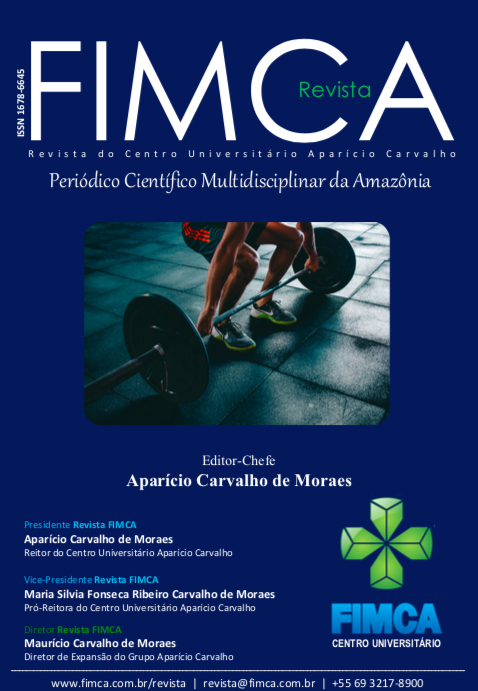LEVANTAMENTO EPIDEMIOLÓGICO DOS REGISTROS DE TUMOR VENÉREO TRANSMISSÍVEL (TVT) ATENDIDOS NO HOSPITAL VETERINÁRIO DA FACULDADES INTEGRADAS APARÍCIO CARVALHO – FIMCA EM PORTO VELHO, RONDÔNIA NO ANO DE 2017
EPIDEMIOLOGICAL SURVEY OF THE RECORDS OF TUMOR TRANSMISSIBLE TUMOR (TVT) ATTENDED IN THE VETERINARY HOSPITAL OF THE INTEGRATED COLLEGES APARÍCIO CARVALHO IN PORTO VELHO, RONDÔNIA IN THE YEAR 2017
DOI:
https://doi.org/10.37157/fimca.v6i3.26Palavras-chave:
Patogenia contagiosa, neoplasia, tumor histiocitário, linfossarcoma transmissível, cães, prevalência, Contagious pathogenesis, histiocytic tumor, transmissible lymphosarcoma, dogs, prevalenceResumo
Introdução: O Tumor Venéreo Transmissível (TVT) é uma patogenia contagiosa, descrita pela primeira vez em 1905 por Sticker com a denominação de linfossarcoma transmissível com localização predominante na região genital. O TVT é um tumor histiocitário e que pode ser transmitido entre cães através do coito, se lambendo, mordendo e cheirando nódulos tumorais nas áreas afetadas. Podendo ser transmitido a outras espécies de caninos, tais como raposas e cachorro do mato. Objetivo: Quantificar os casos remanescente de TVT (tumor venéreo transmissível) encontrados no Hospital Veterinário da Faculdades Integradas Aparício Carvalho- FIMCA de Porto Velho-RO, para que posso beneficiar os Médicos Veterinários e tutores em relação a ocorrência dessa patologia. Material e métodos: O método de coleta das informações foi feito através do livro de registro, no qual havia dados sobre a data de entrada e saída do animal no hospital, nome do animal e do tutor, sexo, raça, diagnóstico ou suspeita clínica e o médico veterinário responsável pelo atendimento, sendo que, destes dados, foram recolhidos apenas, sexo, raça e diagnóstico positivo para TVT. Resultados: Quanto ao comportamento populacional da TVT nos cães atendidos no Hospital Veterinário, a prevalência foi de 0,82% (16/1948). Dos animais avaliados, 31,25% são fêmeas e 68,75% são machos, e considerando as raças foram encontrados tais valores de 68,75% sem raça definida; 12,5% PitBull; 12,5% Pinscher; 6,25% Rottweiler. Conclusão: Neste estudo foi encontrada uma baixa frequência desta doença, porém mesmo com valores obtidos ainda há perigo e possibilidade dos animais de estimação contrair está patologia.
Introduction: Transmissible Venereal Tumor (TVT) is a contagious pathogenesis, first described in 1905 by Sticker with the name of transmissible lymphosarcoma with predominant location in the genital region. TVT is a histiocytic tumor and can be transmitted between dogs through intercourse, licking, biting and smelling tumoral nodules in the affected areas. It can be transmitted to other species of canines, such as foxes and wild dog. Objective: To quantify the remaining cases of TST (transmissible venereal tumor) found in the Veterinary Hospital of Faculdades Integradas Aparício Carvalho-FIMCA in Porto Velho-RO, so that I can benefit Veterinarians and tutors in relation to the occurrence of this pathology. Material and methods: The method of collecting the information was done through the log book, which had data on the date of entry and exit of the animal into the hospital, animal and guardian name, gender, race, diagnosis or clinical suspicion and the veterinarian responsible for the care, and, from data, were collected only, sex, race and positive diagnosis for TVT. Results: Regarding the TVT population behavior in dogs attended at the Veterinary Hospital, the prevalence was 0.82% (16/1948). Of the animals evaluated, 31.25% are females and 68.75% are males, and considering the races were found such values of 68.75% without defined race; 12.5% PitBull; 12.5% Pinscher; 6.25% Rottweiler. Conclusion: This study a low frequency of this disease was found, but even with values obtained there is still danger and the possibility of the animals to contract this pathology.
Publicado
Como Citar
Edição
Seção
A Revista FIMCA disponibiliza seus artigos e resumos para livre acesso de forma permanente e gratuita nos termos da Creative Commons Attribution License, permitindo que a sociedade possa compartilhar (copiar e redistribuir o material em qualquer suporte ou formato para qualquer fim, mesmo que comercial) e adaptar (remixar, transformar, e criar a partir do material para qualquer fim, mesmo que comercial), desde que seja dado o devido crédito apropriado, provendo um link para a licença e indicar se mudanças foram feitas.
Vale a pena ressaltar, que mesmo que o material seja transformado, modificado, ou der origem a outro material, este deve ser distribuido respeitando obrigatoriamente a citação do original nos termos da licença CC BY-AS 4.0 DEED.

















